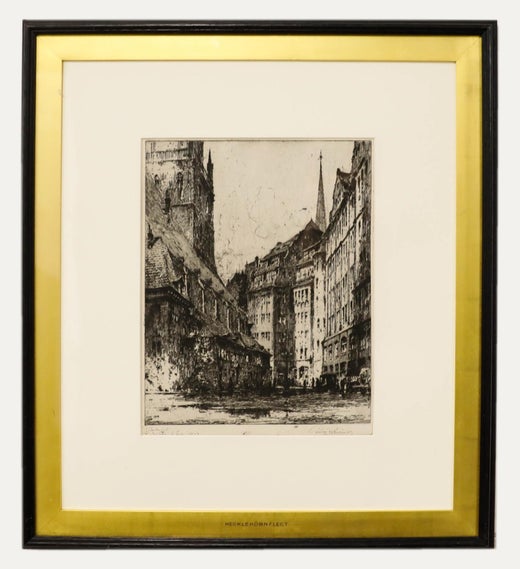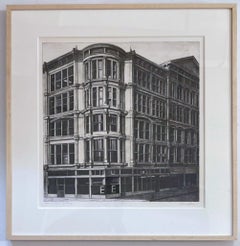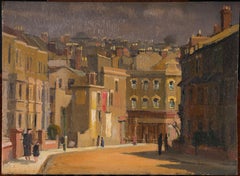Want more images or videos?
Request additional images or videos from the seller
1 of 12
Luigi KasimirLondon, Holborn House1920
1920
$750
£573.42
€656.99
CA$1,057.88
A$1,151.76
CHF 615
MX$13,903.57
NOK 7,731.70
SEK 7,191.38
DKK 4,907.40
About the Item
This artwork titled "London, Holborn House" 1920 is an etching by Austrian artist Luigi Kasimir 1881-1962. It is hand signed in pencil by the artist at the lower right corner. The image size is 14.75 x 13 inches, plate mark is 15 x 13.35 inches, framed size is 23.65 x 22 inches. Custom framed in a wooden black/silver frame, with light beige matting and black fillet. It is in excellent condition.
About the artist.
Luigi Kasimir was born in 1881 at Pettau, today Ptuj, Slovenia, then a part of the Austro-Hungarian monarchy. He inherited his talent from his ancestors; his grandfather was a painter and a poet, and his father an officer in the Habsburg army, who later became a professional painter. Kasimir attended the Vienna Academy of Art where he studied under Wilhelm Unger, who introduced him to the technique of the coloured etching, and also to his future wife, the artist Tanna Hoernes.[1] He died in 1962 in Grinzing, a suburb of Vienna.Kasimir was among the first to develop the technique of the coloured etching. Before this, prints were usually hand-coloured with the colour being applied in a casual, haphazard manner. Kasimir would first create a sketch usually in pastel, he then transferred the design on as many as four to six plates, printing one after the other and applying the colour on the plate, all done by hand.
Kasimir is mainly famous for his etchings, but he also produced some oil painting, as well as some pastels. One of his favourite genres was the landscape, or veduta. He demonstrated a predisposition street scenes, and tourist landmarks. He depicted places from all over Europe, mainly Italy, Austria, and Germany. He also travelled to the United States to do a series of etchings of famous sights ranging from urban landmarks such as New York City skyscrapers, to natural wonders like Yosemite Valley. Luigi Kasimir’s etchings can be seen in many galleries and museums, from the New York Metropolitan Museum of Art to countless galleries and fine print collections around the world.
- Creator:Luigi Kasimir (1881 - 1962, Austro-Hungarian)
- Creation Year:1920
- Dimensions:Height: 23.65 in (60.08 cm)Width: 22 in (55.88 cm)Depth: 0.75 in (1.91 cm)
- Medium:
- Movement & Style:
- Period:
- Condition:
- Gallery Location:San Francisco, CA
- Reference Number:Seller: Kas/hol/lon/011stDibs: LU666312973492
Luigi Kasimir
Alois Heinrich “Luigi” Kasimir (Austrian, 1881-1962) was born on April 18, 1881 in Ptuj, Austria (today Slovenia) then a part of the Austro-Hungarian monarchy. He may have inherited his talent from his ancestors; his grandfather was a painter and a poet, and his father, an officer in the Habsburg army, who later became a professional painter. Kasimir attended the Vienna Academy of Art where he studied under Willhelm Unger, who introduced him to the technique of the color etching, and also to his future wife, the artist Tanna Hoernes. Kasimir was among the early practitioners of the multi-plate color etching. Before this, prints were usually hand-colored with the color being applied in a casual, haphazard manner. Kasimir would first create a sketch—usually in pastel. He then transferred the design on as many as four to six plates, printing one after the other and applying the color to the plate - all done by hand. Although Luigi Kasimir is mainly famous for his etchings, but he also produced some oil painting, as well as some pastels. One of his favorite genres was the landscape. He demonstrated a predisposition for monuments, street scenes, and tourist landmarks. He depicted places from all over Europe, mainly Italy, Austria, and Germany. He also travelled to the United States to do a series of etchings of famous sights ranging from urban landmarks such as New York skyscrapers to natural wonders like California’s Yosemite Valley. Kasimir designed a bookplate for Sigmund Freud, who also hung an etching of the Roman Forum by Kasimir in his consulting room. Kasimir’s wife, Tanna and their son Robert worked in a similar style. Luigi Kasimir died in 1962 in Grinzing, a suburb of Vienna, Austria
About the Seller
5.0
Platinum Seller
Premium sellers with a 4.7+ rating and 24-hour response times
Established in 1999
1stDibs seller since 2017
869 sales on 1stDibs
Typical response time: <1 hour
- ShippingRetrieving quote...Shipping from: San Francisco, CA
- Return Policy
More From This Seller
View AllFleet Street, London
By Luigi Kasimir
Located in San Francisco, CA
This artwork titled "Fleet Street, London" c.1925 is a color etching by Austrian artist Luigi Kasimir 1881-1962. It is hand signed in pencil by the artist estate at the lower center. The plate mark (image) size is 20.5 x 15 inches, framed size is 34 x 28 inches. Custom framed in the wooden original brown and gold distressed style frame, with light beige fabric matting and gold color fillet. It is in excellent condition, the frame have very small minor restorations, practically invisible.
About the artist.
Luigi Kasimir was born in 1881 at Pettau, today Ptuj, Slovenia, then a part of the Austro-Hungarian monarchy. He inherited his talent from his ancestors; his grandfather was a painter and a poet, and his father an officer in the Habsburg army, who later became a professional painter. Kasimir attended the Vienna Academy of Art where he studied under Wilhelm Unger, who introduced him to the technique of the coloured etching, and also to his future wife, the artist Tanna Hoernes...
Category
Early 20th Century Realist Figurative Prints
Materials
Etching
Weinstube Street, Urbani Keller
By Luigi Kasimir
Located in San Francisco, CA
This artwork titled "Weinstube Street, Urbani Keller" c.1920, is an etching on paper by Austrian artist Luigi Kasimir 1881-1962. It is hand signed in pencil at the lower right corner and inscribed on the left. The plate mark (image) size is 14 x 9.5 inches, framed size is 26.35 x 21.5 inches. Custom framed in a wooden black/silver frame, with off white matting and black color fillets. It is in excellent condition.
About the artist.
Luigi Kasimir was born in 1881 at Pettau, today Ptuj, Slovenia, then a part of the Austro-Hungarian monarchy. He inherited his talent from his ancestors; his grandfather was a painter and a poet, and his father an officer in the Habsburg army, who later became a professional painter. Kasimir attended the Vienna Academy of Art where he studied under Wilhelm Unger, who introduced him to the technique of the coloured etching, and also to his future wife, the artist Tanna Hoernes.[1] He died in 1962 in Grinzing, a suburb of Vienna.Kasimir was among the first to develop the technique of the coloured etching. Before this, prints were usually hand-coloured with the colour being applied in a casual, haphazard manner. Kasimir would first create a sketch usually in pastel, he then transferred the design on as many as four to six plates, printing one after the other and applying the colour on the plate, all done by hand.
Kasimir is mainly famous for his etchings, but he also produced some oil painting, as well as some pastels. One of his favourite genres was the landscape, or veduta. He demonstrated a predisposition street scenes, and tourist landmarks. He depicted places from all over Europe, mainly Italy, Austria, and Germany. He also travelled to the United States to do a series of etchings of famous sights ranging from urban landmarks such as New York City skyscrapers, to natural wonders like Yosemite Valley. Luigi Kasimir’s etchings...
Category
Early 20th Century Realist Figurative Prints
Materials
Etching
Turmgasschen
By Luigi Kasimir
Located in San Francisco, CA
This artwork titled "Turmgasschen" 1935 is an original color etching by Austrian artist Luigi Kasimir 1881-1962. It is hand signed in pencil at the lower center by the artist and titled in the plate. The plate mark (image) size is 15.5 x 10 inches, framed is 24.35 x 17.5 inches. It is custom framed in a dark wood frame, with light creme color matting and light brown filet. It is in very good condition, the frame have some scratches.
Luigi Kasimir was born in 1881 at Pettau, today Ptuj, Slovenia, then a part of the Austro-Hungarian monarchy. He inherited his talent from his ancestors; his grandfather was a painter and a poet, and his father an officer in the Habsburg army, who later became a professional painter. Kasimir attended the Vienna Academy of Art where he studied under Wilhelm Unger, who introduced him to the technique of the coloured etching, and also to his future wife, the artist Tanna Hoernes.[1] He died in 1962 in Grinzing, a suburb of Vienna.Kasimir was among the first to develop the technique of the coloured etching. Before this, prints were usually hand-coloured with the colour being applied in a casual, haphazard manner. Kasimir would first create a sketch usually in pastel, he then transferred the design on as many as four to six plates, printing one after the other and applying the colour on the plate, all done by hand.
Kasimir is mainly famous for his etchings, but he also produced some oil painting, as well as some pastels. One of his favourite genres was the landscape, or veduta. He demonstrated a predisposition street scenes, and tourist landmarks. He depicted places from all over Europe, mainly Italy, Austria, and Germany. He also travelled to the United States to do a series of etchings of famous sights ranging from urban landmarks such as New York City skyscrapers, to natural wonders like Yosemite Valley. Luigi Kasimir’s etchings...
Category
Early 20th Century Realist Figurative Prints
Materials
Etching
Cityscape
By Josef Eidenberger
Located in San Francisco, CA
This artwork "cityscape" c. 1960 is a color etching by noted Austrian artist Josef Eidenberger, 1899-1991. It is hand signed in pencil by the artist. The plate mark (image) size is 1...
Category
Mid-20th Century Realist Figurative Prints
Materials
Etching
Wien
By Luigi Kasimir
Located in San Francisco, CA
This artwork titled "Wien" 1911, is a color etching on paper by Austrian artist Luigi Kasimir, 1881-1962. It is hand signed in pencil by the artist's estate at the lower center. The ...
Category
Early 20th Century Realist Figurative Prints
Materials
Etching
Frankfurt, Germany
By Luigi Kasimir
Located in San Francisco, CA
This artwork "Frankfurt, Germany" c.1930 is an original color etching by Austrian artist Luigi Kasimir 1881-1962. It is hand signed in pencil at the lower center. The plate mark (ima...
Category
Early 20th Century Realist Figurative Prints
Materials
Etching
You May Also Like
Fleet Street, London
By Luigi Kasimir
Located in Fairlawn, OH
Fleet Street, London
Soft ground etching & aquatint, c. 1936
Signed in pencil by the artist (see photo)
Condition: Very good condition with brown paper tape along the edges of the la...
Category
1930s Landscape Prints
Materials
Etching, Woodcut
The Hugh O'Neill Building, 655-671 Sixth Avenue, NYC, lithograph Signed/N Framed
By Richard Haas
Located in New York, NY
Richard Haas
The Hugh O'Neill Building, 655-671 Sixth Avenue, New York City, 1974
Lithograph on Arches paper
Signed, titled and annotated "TP" in graphite pencil on the front
Edition...
Category
1970s Realist Landscape Prints
Materials
Lithograph
Urban cityscape
Located in Douglas, Isle of Man
This urban landscape is certainly a British city possibly Bristol, the artist is believed to be John William Ashton, known as Will Ashton. The painting dates from around 1900, before WW1, there is a pillar box for post to the rear of the picture which displays certainly a British town or city and in our opinion almost certainly Bristol, England. This is a very small but well executed paining in oil by an accomplished artist, the painting itself measures 4.5 x 6.5 inches and has been mounted in a new and suitable frame by our professional framer who's decision to mount the picture as shown was clearly an admiral choice. I have enclosed a biography of Will Ashton. This painting is unsigned.
Sir John William Ashton, OBE, ROI (20 September 1881 – 1 September 1963) was a prolific Australian Impressionist artist and director of the Art Gallery of New South Wales from 1937 to 1943.
Early life
Ashton was born in Clifton, York, England, the only son of artist James Ashton, and his wife Mary Elizabeth Ashton. His father immigrated to Australia, arriving at Adelaide, South Australia in January 1884 and founding a school of painting in "unpretentious but commodious" premises on The Parade, Norwood in 1885. His wife and son arrived at a later date, but generally given as in 1884.
Ashton attended Prince Alfred College, where his father was art teacher, from 1889 to 1897. Neither academically nor athletically inclined. On leaving school, he received further training from his father; Hans Heysen was a fellow student.
He left for London in 1900, where he studied at the Olsson-Talmage studios, then in 1902 at the Académie Julian in Paris for a year. Ashton had several paintings accepted by the Royal Academy of Arts, London, and the Salon de la Société des Artistes Français, around which time he adopted the name "Will Ashton" to avoid confusion with his father or Julian Ashton (no relation). In 1905 he returned to Adelaide, where his "Boulevard Montparnasse, Paris" was hailed as a masterpiece, and purchased by the Art Gallery of South Australia. After holding exhibitions in Sydney, Melbourne, Perth and Adelaide, in 1908, he won the Wynne Prize for landscapes.
In the years 1912–1914 he painted in Britain, Europe, and Egypt. He returned to Australia for a year, but was back in London with his family 1915–1917. He made other trips in company with Lionel Lindsay...
Category
Early 20th Century Landscape Paintings
Materials
Oil, Board
Palace Court
By Frederick Landseer Griggs, R.A., R.E.
Located in New York, NY
Frederick Landseer Griggs (1876-1938), Palace Court, 1933, etching, signed and inscribed in pencil. Reference: Comstock 49, third state (of 3), from the printing of about 75. In exce...
Category
1930s Realist Landscape Prints
Materials
Etching
"European Cityscape"
Located in Edinburgh, GB
Franz Alt (1821–1914)
European Cityscape
Watercolor on paper
Framed: 51 x 46 cm Paper: 27 x 34 cm
No signatured
This masterful watercolor by Franz Alt, a celebrated Austrian artist...
Category
19th Century Realist Interior Paintings
Materials
Paper, Watercolor
New York, Courtland Street
By Jean-Emile Laboureur
Located in Roma, IT
Etching, 1908.
Image Dimensions: 30 x 17 cm
Hand signed and signed on plate.
Provenance: Galleria Prandi 26/10/1976.
Jean-Émile Laboureur was a French painter, illustrator and engra...
Category
Early 1900s Realist Landscape Prints
Materials
Etching
More Ways To Browse
Original Toulouse Lautrec Lithograph
Peter Sager
Picasso Saltimbanques
Picture Of Dorian Gray
Pierre Casanova
Police Mugshot
Privat Livemont
Rene Portocarrero
Renoir Drawings
Royal Albert Old Country Roses
Salvador Dali 1967
Salvador Dali Mythology
Sem Georges Goursat
Sonia Delaunay Pochoirs
Toyokuni Ii
Vermeer Lithograph
Vintage 1945 Dresses
Vintage Broadway Posters



